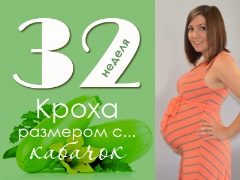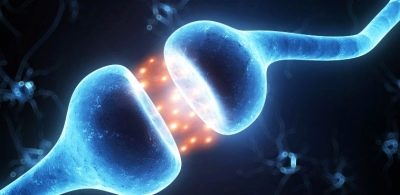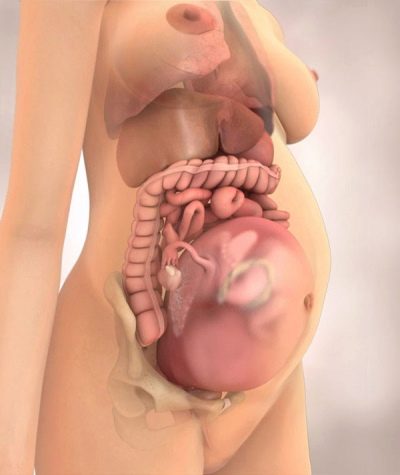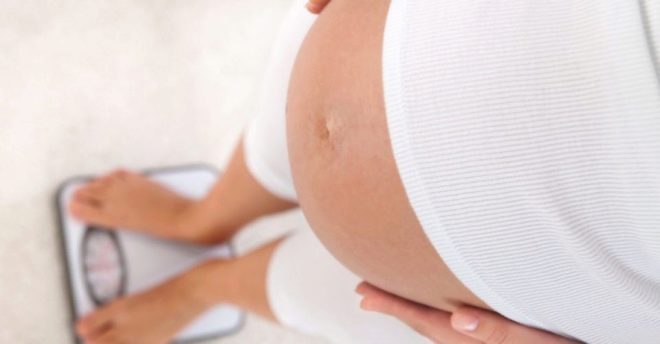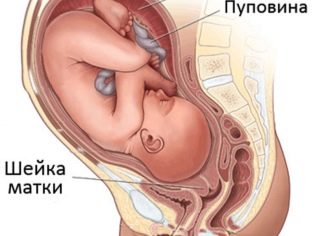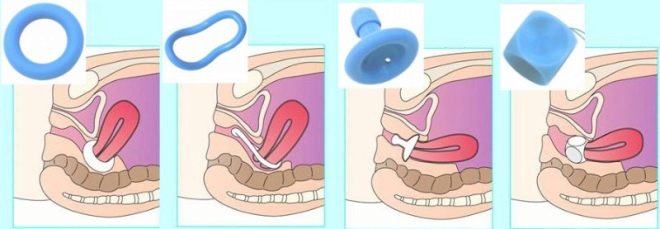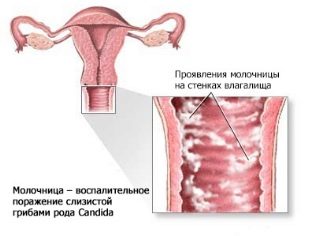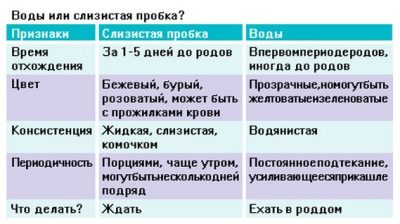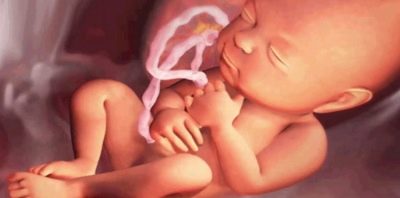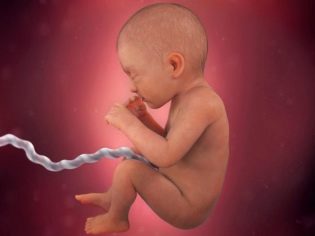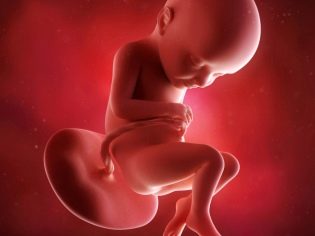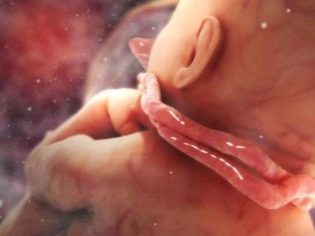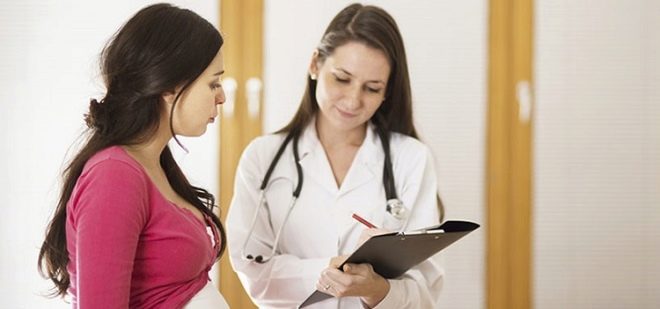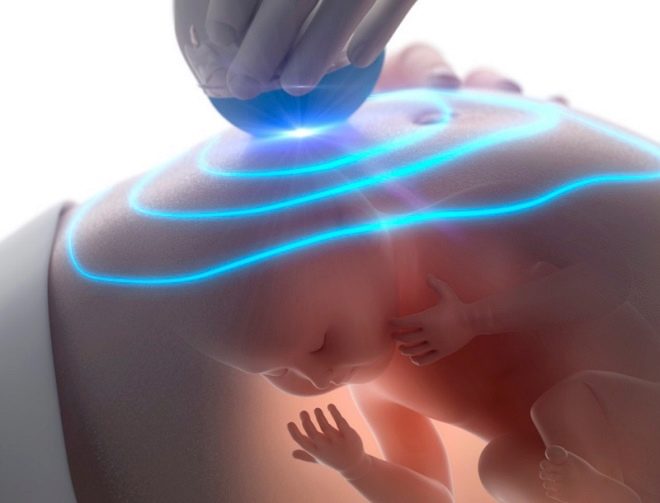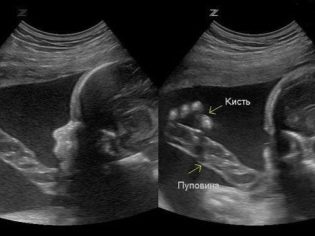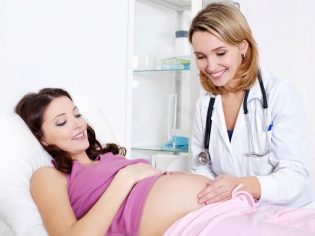What happens to the fetus and the future mother at 32 weeks of pregnancy?
Each stage of pregnancy development is unique. Every week, hundreds of different changes occur with mother and baby. Many interesting processes occur at 32 weeks gestation.
How many months is it
This term is considered to be the eighth obstetric month. Also, this period corresponds to the age of the fetus, equal to 30 weeks from conception. The difference in the timing is due to the different method of counting, which is used by gynecologists.
It should be noted that the term “obstetric week” is more often used. This allows doctors of different specialties to "speak" in one language, using common terminology.
Mother features
At 31-32 weeks of pregnancy, the expectant mother begins to gradually prepare for childbirth. In her body begin to occur changes characteristic of this period. Gradually, her hormones are changing, there is a temporary restructuring of the internal organs. These changes are necessary for the baby to be born in time.
Physiology
In this period in the female body in the blood begin to form special hormones required for natural childbirth. One of these substances is relaxin. Under its influence, specific changes occur in the ligamentous and muscular apparatus of the pelvis. So, the muscles become much more elastic. This is necessary to ensure that during the passage of the baby through the birth canal, dangerous injuries and damage to soft tissues do not occur.
Another biologically active substance that gradually begins to be synthesized in the female body is prolactin. The increase in its concentration contributes to the fact that the chest begins to ache and grow. This kind of preparation of the female body is necessary for the next stage to begin after the baby is born - lactation.
At 32 weeks of pregnancy, the circumference of the maternal tummy is already quite large. The navel of many women is drawn inward. The larger the abdomen, the brighter this feature appears.
If the baby is quite large, then the raised maternal tummy puts a lot of pressure on the diaphragm. This leads to the fact that the woman's breath changes. She may also feel some soreness and sensitivity in the lower parts of the chest.
Some women on the body may increase hair growth. In some cases, the hair begins to grow on the "male" type. These changes also result in altered hormones. Most often, such a clinical sign develops in women who expect the birth of sons.
After the baby is born, the level of hormones gradually normalizes, and this symptom disappears. If this does not happen, then the woman should consult with her gynecologist, and in some cases with an endocrinologist.
During each period of pregnancy, doctors must evaluate the weight gain of the expectant mother.This simple method of clinical research allows the doctor to assess the condition of a woman and the indirect signs of a child’s growth. Weight gain must be monitored. This should be done with the advice of doctors.
Average, By this time of pregnancy, the total weight gain of a woman is eleven kilograms. With multiple pregnancies, this indicator may be different.
Overall weight gain is an indicative clinical indicator. The doctor cannot rely only on it to assess fetal development. For this, he uses other research methods.
Sensations
At this time of pregnancy, the expectant mother already feels quite strongly her baby inside. Its general condition also changes. Some women also note that during pregnancy, their mood and attitude towards life changed.
Such changes are due to nature. The female organism is, as it were, tuned to a new quality. Of course, a changing state can be manifested by the appearance of many different symptoms.
Changes in mood and behavior
The changing hormonal background leads to the fact that expectant mothers begin to experience mood swings. Something they resemble similar changes that manifested themselves in the very early weeks of pregnancy. Also closer to childbirth, a woman begins to increase nervousness and anxiety.
Hormonal changes contribute to the fact that many expectant mothers at this stage of pregnancy constantly want to sleep. This may increase daytime sleepiness.
At night, however, some women may have difficulty falling asleep. The greater the suspiciousness and anxiety of a woman because of the nature of her character and psychological characteristics of the person, the more vividly this symptom appears. Many expectant mothers at this stage of pregnancy complain to their doctors that they have insomnia.
The ability to withstand the effects of strong psycho-emotional stress also decreases somewhat. Such changes occur due to the fact that the female body is gradually preparing for the upcoming delivery.
At this stage of pregnancy, it becomes difficult for a woman to cope with a large amount of information. Her memory decreases slightly, concentration decreases.
Even after the usual mental stress, a woman may experience a headache. In order not to provoke the development of these adverse symptoms, the expectant mother should rest more.
Sensations in the stomach
By this time of pregnancy, the expectant mother often feels frequent “shocks” along the lower edge of the costal arch. This is due to the fact that the child is already quite large in size and is moving quite actively. As a rule, by this time of its prenatal development, the baby has already dropped its head down towards the birth canal.
Reviews of women who have already become mothers, indicate that many of them quite often felt such “blows” of a baby in their stomach. To somewhat reduce the pain and discomfort, they leaned back a little on the back of the sofa.
This position provides the baby with more space. Mom while feeling somewhat better. Light and deep breathing will also help the child calm down gradually.
Pregnant women at this stage of pregnancy may experience unpleasant pulling pain in the lower abdomen. Such symptoms occur due to the fact that the pelvic floor somewhat expands during this period of carrying a baby. Such an organism response is quite physiological before the upcoming genera.
At the 32nd week of gestation, the first training bouts also often begin to manifest themselves. Usually they are detected during CTG. They can also feel the woman herself.
They are felt, as a rule, as short and moderate in intensity contractions in the lower abdomen.There are such training contractions as a result of the contraction of the uterine walls. You should not be afraid of them. Also, they are not the result of imminent labor.
When such sensations appear, it is very important to immediately consult a doctor. The doctor will conduct a gynecological examination with an assessment of the condition of the cervix. If its disclosure is insignificant, then worry about the imminent onset of labor is not worth it. In this situation, the doctor will make recommendations for the future mother regarding how to wait for the calculated period of natural childbirth.
Other changes in the body
Quite often in this period of pregnancy a woman feels that she has a backache. The larger the baby and the narrower the pelvis of the expectant mother, the more such symptoms can be expressed. In order to reduce them somewhat, doctors recommend expectant mothers to rest more.
At this stage of pregnancy, women often have swelling of the legs. Both physiological and pathological causes can lead to the development of this adverse symptom.
The growing uterus exerts strong pressure on adjacent organs, which include the urinary tract. This feature contributes to the fact that the flow of urine through the ureters decreases.
These changes are beginning to cause the future mother appearance of edema. It is important to note that swelling can occur on different parts of the body, most often on the legs.
However, swelling can also appear on the face - in the area below the lower eyelids. If the swelling of the face of a woman is strongly pronounced, then this can lead to a change in the oval of her face. It becomes more rounded, natural folds at the same time somewhat smoothed out.
Errors in nutrition often contribute to the appearance of various unpleasant sensations in the future mother. Some women begin to feel heartburn. If the correction of the diet does not bring pronounced relief, the expectant mother should always consult with your doctor.
To improve your overall condition, you should exclude fatty and fried foods from your daily diet. This food contributes to violations in the liver and gallbladder. It is extremely important to monitor the nutrition of women suffering from chronic cholecystitis and other diseases of internal organs.
Some women may feel that their body is itchy. The development of this symptom can also contribute to various hormonal changes.
The severity of this feeling may be different. With the appearance of this symptom it is very important to consult a doctor. In some cases, chronic diseases of internal organs also lead to its appearance.
The disruption of the gastrointestinal tract may contribute to the development of other unpleasant symptoms. Often, pregnant women at this stage of pregnancy complain to their doctors that they manifest various disorders of the stool - both diarrhea and constipation. To normalize the stool requires the selection of the correct diet.
It is very important that the expectant mother takes all the necessary substances, as well as vitamins and trace elements. To do this, she should eat a lot of fruits and vegetables, dairy products. Such nutrition will help improve the performance of intestinal microflora, which will positively affect the stool.
32 week of pregnancy is the time when the female body is actively preparing for the baby to be born. After the birth of a child, another, no less responsible period begins - lactation. To prepare for this period, hormones begin to be synthesized in the future mother’s body, leading to the appearance of colostrum, a special fluid secreted from the mammary glands necessary for feeding the baby for the first time after birth.
Over time, the chemical properties of colostrum change. At first it is quite thick, then it becomes more liquid.Such a feature was invented by nature so that the baby receives all the necessary substances for its full growth and development.
What can bother a pregnant at this time?
Even with the physiological course of pregnancy, women may experience various changes. They lead to the fact that the future mom has certain clinical conditions. At each stage of pregnancy, such manifestations may be different.
Reduced immunity
Various specific changes may also occur during pregnancy. So, while carrying a baby, the mother’s immunity is somewhat reduced. This is necessary so that the woman’s immune system does not reject the child after conception, and then later during his development. Such a decrease in immunity is also necessary in order for the maternal organism to perceive the baby not as an alien genetic object, but as its own.
However, in this case there are downsides. The somewhat reduced work of the immune system leads to the fact that the resistance of women at 30-32 weeks of pregnancy to various viral and bacterial infections is reduced.
Expectant mother can easily become infected. Also not a small risk of a cold. SARS and respiratory diseases are often registered with expectant mothers at this time.
It is very important that the future mother remembers this feature and carefully protects herself from possible colds.
Mouth problems
Diseases of the teeth during pregnancy are quite common. Hormonal changes lead to the development of specific changes in the oral cavity. For example, the changing concentration of estrogen in the blood of the expectant mother contributes to the appearance of increased bleeding gums. In some women, this condition can lead to toothache and the development of periodontal disease.
Reduce adverse symptoms can be achieved by using special mouthwash and gentle toothpastes. It is better that these funds were made on the basis of medicinal herbs. You can also rinse your mouth with a decoction of sage or chamomile, cooked at home.
Makes a set of advanced recommendations dentist. If the future mother has a toothache, she should immediately consult a doctor. To worry and not worry. Currently, in the arsenal of specialists there are quite a few dental treatments that are safe and can be applied to pregnant women.
Disturbances in the reproductive organs
During the gynecological examination, doctors necessarily evaluate the length of the cervix. The condition of this body is very important.
In gynecological practice, there are many different pathologies associated with shortening of the cervix. These conditions are quite dangerous. Short cervix increases the risk of preterm labor.
Also, this pathology may contribute to the development of cervical insufficiency. If it is not treated in time, this pathological condition can be a threat to the birth of the baby ahead of schedule.
Doctors use various methods to correct this pathology. The treatment regimen is selected individually. For the correction of the violations that have occurred, specialists can select a hormone therapy method for the expectant mother. In this case, the drug Utrozhestan is most often used.
For isthmic-cervical insufficiency caused by a shortened cervix, special obstetric devices - pessaries can also be used. They are installed in the vagina. This procedure is carried out only by a doctor.
The use of pessaries significantly reduces the risk of having babies much earlier than the established deadlines. The use of such obstetric devices is limited to certain medical indications and contraindications.After installing the pessary, the doctor is sure to observe the condition of the woman.
During pregnancy, doctors estimate a lot of clinical parameters, one of which is uterine tone. In an excessively active form, it can lead to the development of dangerous states for the fetus. In this case, the doctor must make a set of recommendations for the future mother. With a high threat to the life of the baby, the doctor will advise the woman to limit sex.
It is important to note that such recommendations are made individually. To do this, the doctor must evaluate the condition of the baby and the well-being of the future mother.
In women at this stage of pregnancy, feelings of sexuality change physiologically. For example, subjective changes in orgasm occur. The future mother should be sure to discuss the possibility of having sex during this term of pregnancy with her doctor.
Reduced local immunity and changing hormones often contribute to the fact that a woman has thrush. Also, nutritional errors with the abuse of sweets and chocolate can also lead to the development of this disease.
Thrush is usually accompanied by the development of many adverse symptoms, one of which is the appearance of itching in an intimate place. The degree of severity may be different. Some women experience quite strong discomfort. Also with this pathology, specific secretions appear in the vagina, resembling “cheesy flakes”. If adverse symptoms occur, it is very important to consult a doctor.
To eliminate them may require special antifungal drugs. Also, the doctor will recommend an intimate hygiene to a future mother. Many of them can be further used not only for the purpose of treatment, but also for the prevention of the development of adverse symptoms.
At this stage of pregnancy, a woman may have a mucus plug from the genital tract. In such a situation it is very important to immediately consult a doctor. In this case, the risk of preterm birth is quite high.
When a cork ejects, the future mother should not panic, first of all. With the development of this situation, the physician must necessarily assess how close the approach of labor. It often happens that a pregnant woman is hospitalized for further observation. Obstetricians note that there are quite a lot of babies born at week 32 of pregnancy.
Features a child
In the development of babies at this time there are common clinical signs. However, there may be differences. They do not always indicate only the development of any pathology or developmental disabilities. It also happens that such features are physiological. Their appearance is influenced by many factors, for example, the features of the constitution and the body structure of the parents.
Determine the boundaries of the norm and pathology can only a doctor who observes the future mommy during her pregnancy. To help the doctor come modern research methods and various analyzes.
Physiology
To assess the development of intrauterine development of babies at this time, doctors use various clinical indicators. The basic ones are the anatomical parameters of the fetus:
- At this stage of pregnancy baby weight already reaches 1800 grams. The growth of the child is approximately 42 cm. For multiple pregnancies, these parameters may be different. As a rule, in this case, one baby is slightly larger than the other. It is extremely rare in obstetric practice there are cases when both twins or twins have the same size.
- Head circumference baby is about 28.5-32.5 cm. When conducting a study, you can also measure the parameters of other anatomical structures. Thus, the circumference of the child’s tummy at this stage is approximately 25.8-31.4 cm.
- During the study, the ultrasound specialist can also determine sizes of some bones. Thus, the hip length of the baby at this time is 5.5-6.5 cm, the shoulder is 5.3-6.3 mm, and the bones of the tibia reach sizes 5.3-6 cm.
Development
The baby at this stage of its prenatal development is already quite strongly developed. So, the baby already has hair and cilia. Over time, the hair on his body will change. Gradually downy hairs disappear.
At this period of its prenatal development, the baby is already quite active. If there is a sufficient amount of fluid in the mother's womb, the child can comfortably perform his active movements. They can be distinguished especially well during ultrasound.
The child begins to change the configuration of his body. Thus, adipose tissue gradually accumulates - in this way, the children's organism prepares for the forthcoming birth and transition to a new habitat for it.
Adipose tissue in this case performs an active thermoregulatory function. It helps to protect the baby from hypothermia after birth. Babies born before the deadline often experience problems with thermoregulation.
The position of the baby in the womb is also very important. Many children to this period are already taking the correct position. However, in some cases it may change.
If the baby is too active, the risk of developing pelvic presentation closer to childbirth increases significantly. The importance of the position of the child in the uterus cannot be overemphasized. The location of the baby in the reproductive organ is evaluated when choosing the tactics of delivery in each case.
The position of the child in the uterus, when its head is pointing down, is the most physiologically beneficial. In this case, the natural birth of the baby proceeds, as a rule, much easier. The head of the child has a rather large weight and rounded shape. This allows the baby to move well in the birth canal during his birth.
In addition to the basic parameters of the body of the baby, the doctor necessarily takes into account the features of other organs. One of these specific formations of pregnancy is the placenta. Inside this formation there are quite a lot of blood vessels. Such abundant blood supply is necessary for the full development of the baby. Through them, he gets all the necessary components in order to grow and develop.
During an ultrasound scan and a doppler used at this time, the doctor can determine how well the blood flows through the main blood vessels of the placenta. Violations of the blood supply to the body of a baby can lead to various disorders in its development.
During its prenatal growth, the baby is in the aquatic environment. It is formed by amniotic fluid. In order for the child to fully develop and grow, it requires a sufficient amount.
Doctors use a special criterion to determine this important clinical indicator. It is measured during an ultrasound examination. This indicator is called the index of amniotic fluid (IAI).
If it is too low, this condition can be extremely dangerous and lead to the development of various pathologies for the life of the fetus. If at the time of the ultrasound examination the specialist revealed a decrease in this index, then he must indicate this in his opinion. In this case Obligatory consultation of an obstetrician-gynecologist for the selection of further tactics for pregnancy management is necessary.
Possible pathology in the baby
This period of pregnancy is very important. During this period, the child may experience dangerous pathologies. In some cases, they can be an indication for emergency delivery. The urgency of this measure is largely due to the risk of a baby’s life or threatening conditions for a woman.
Being in my mother's tummy, the baby receives all the necessary substances through the umbilical cord.It includes blood vessels. The length of the umbilical cord may be different. This is influenced by the most diverse factors.
If the umbilical cord is too short, it can lead to the development of numerous pathologies. This condition will not allow the child to fully move through the birth canal at the time of his birth. In this situation, as a rule, doctors are forced to resort to the surgical method of obstetric aid - cesarean section.
An umbilical cord too long can also lead to the development of specific changes. One of these conditions is a single cord entanglement around the baby’s neck. In some cases, there may even be double and multiple entanglements. This is largely due to the physiological characteristics of the fetus, as well as the immediate length of the umbilical cord.
Often, when this condition is detected during an ultrasound examination of a woman, a real panic attack occurs. Panic should not be! It is important to remember that not in all cases such a condition leads to the “strangulation” of the baby, which is mainly feared by the woman.
To assess the severity of the resulting violations, the doctor must evaluate the condition of the baby inside the mother's womb. It is very important that the child does not have severe hypoxia (oxygen starvation of tissues and internal organs).
It also happens that the fetus can unravel itself. For this, it is necessary that the amount of amniotic fluid is sufficient. It is also important to consider the initial size of the baby. A big child is much more difficult to do.
If an ultrasound specialist revealed this condition to a future mother, then she should immediately consult with her obstetrician-gynecologist. The doctor needs to conduct additional studies aimed at determining the state of the baby.
Also, the doctor will necessarily make up for the future mother a set of recommendations that she should follow through to the birth. In some cases, if the situation requires it, the woman will be hospitalized in the hospital.
Studies on this gestational age
In order to determine how well the baby is developing in my mother's tummy, doctors use various methods of research.
The most common method of diagnosis of various diseases that can be detected at this stage of pregnancy are ultrasound methods. Holding them helps doctors get the necessary information about how well the baby feels in the womb.
The undoubted advantage of such studies is the fact that they are not invasive. During the ultrasound you can see how the baby moves. Volumetric techniques even allow you to determine the expression of the baby's face. Such methods of research include 3D and 4D ultrasound. During the study, the child frowns or smiles if he does not turn away from the ultrasound transducer.
To determine the speed of blood flow and other parameters of the blood supply method is used Doppler. With such a simple study, a specialist can get a lot of necessary information about how well the blood vessels that feed the fetus function.
Many research methods that are used in daily medical practice at this stage of pregnancy should not be performed. Such studies include various radiographic techniques.
An x-ray or CT scan should be done after the baby is born, since the risk of radiation exposure to the body is too high during the study. Only in exceptional cases for special medical reasons, doctors can order such an X-ray examination. In this situation, the possible harm of this diagnostic method to the developing fetus is necessarily taken into account.
Recommendations
32 week of pregnancy is a very important period. At this time, the prenatal development of the baby is already at the final stage.In order for the upcoming birth to be as smooth as possible, the expectant mother should carefully monitor their state of health.
At this time, the woman should have already decided on the choice of the medical institution where the birth will take place in the future. Reviews of many women indicate that at this stage of pregnancy, they were already actively preparing for hospitalization at the maternity hospital.
You can already begin to collect a bag with things that may be needed in a medical facility. Many women say that if they collected their belongings in advance, then in the future they practically did not experience panic, if for some reason the birth began earlier. The future mother should think about what things she will need at the maternity hospital. It is very important that the clothes are comfortable and convenient. Choose narrow and tight things not worth it. At first, after childbirth, comfort is very important.
Also, do not forget the clothes and personal care products for the baby. In many maternity hospitals the list of necessary things for mother and baby is different. It is better to clarify in advance what is required. You should not forget about comfortable comfortable shoes.
Nutrition in late pregnancy is very important. Many women can "seize" the stress of the upcoming delivery. Other future mothers, on the contrary, can completely lose their appetite. Any extremes can be dangerous. It is very important that the nutrition remains balanced. Expectant mother should consume enough protein, fat and carbohydrates. Her menu must contain a variety of products. Reception of multivitamin complexes is discussed with your doctor.
If a pregnant woman has a strong tendency to develop edema, she should carefully monitor the amount of salt consumed. A large amount of salt inevitably leads to swelling on the legs or under the eyes.
A lot of sodium chloride is already contained in finished meat products and semi-finished products. Also a lot of salt is in salted and canned fish. It is better to exclude these products from your food to expectant mothers and eat poultry, fish or meat cooked at home. In this case, the amount of salt can be adjusted independently.
Compliance with the drinking regime during pregnancy also plays a very important role. To fill the fluid is perfect ordinary water. Also, fruit and berry fruit drinks can be used as drinks. It is best to cook them at home. Too much sweeten these drinks are not worth it.
In this period of pregnancy is very important psychological and emotional attitude. The even and calm mood of the woman, as well as the obligatory positive emotions will contribute to the fact that the expectant mother will be less nervous and worried before the upcoming birth. Breathing exercises and relaxation-oriented practices will also help improve overall well-being.
Regular walks in the fresh air have a positive effect on both the maternal organism and the baby. During such walks enough oxygen enters the bloodstream. This is an excellent prevention of fetal hypoxia. Also, regular walks in the park or square will help normalize the work of the nervous system of the future mother.
About what happens to the fetus and the future mother at 32 weeks of gestation, see the following video.
